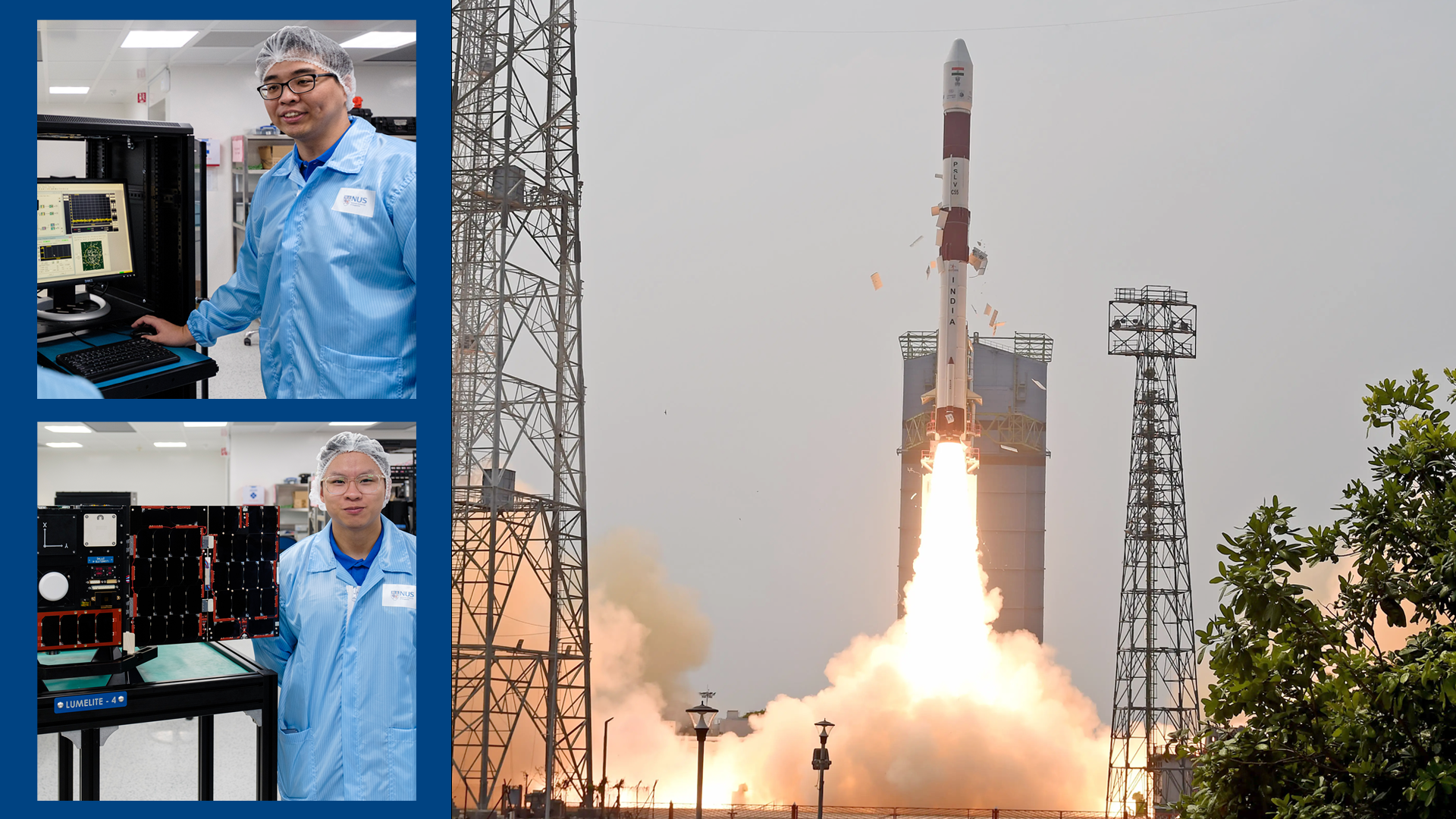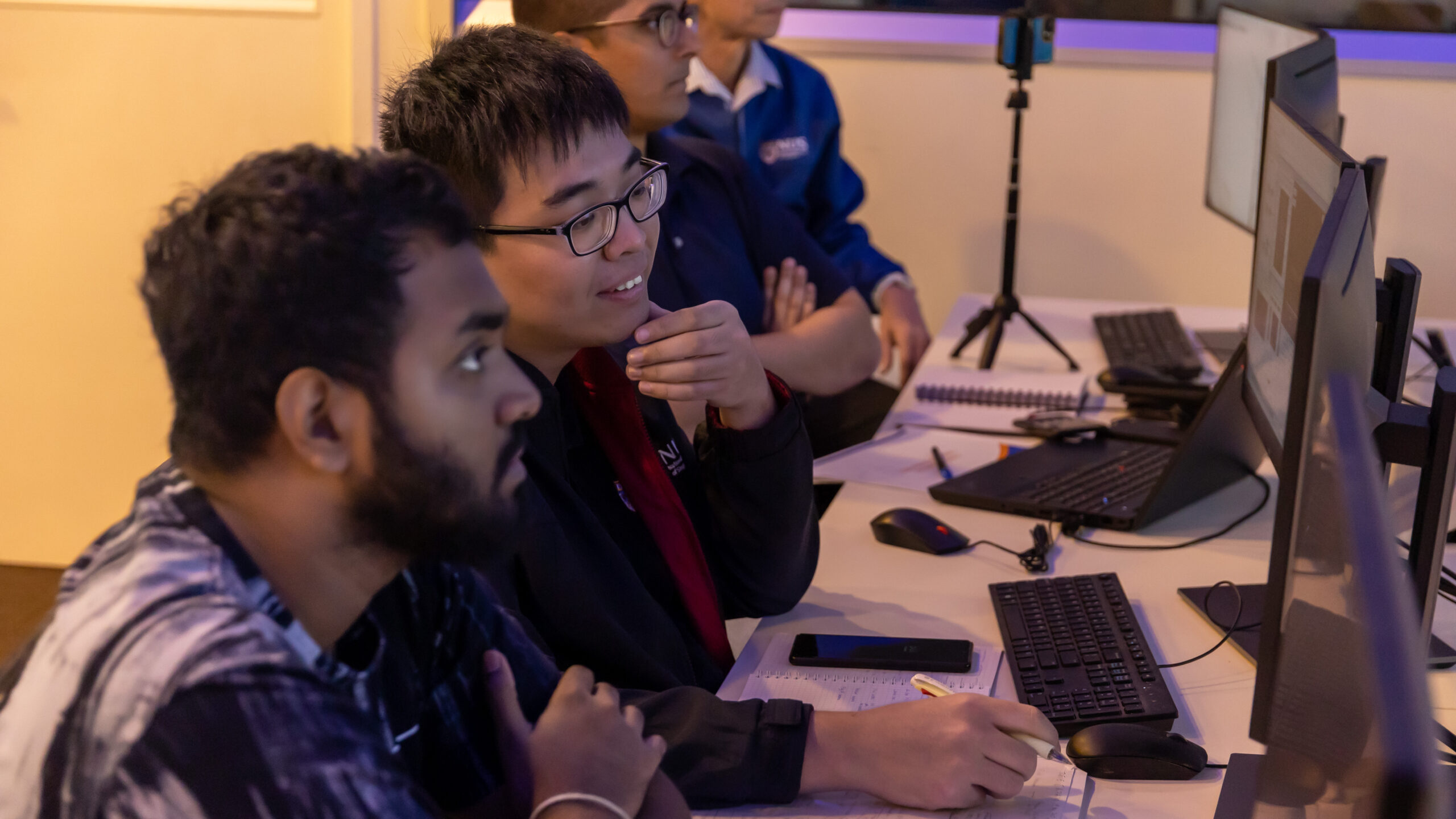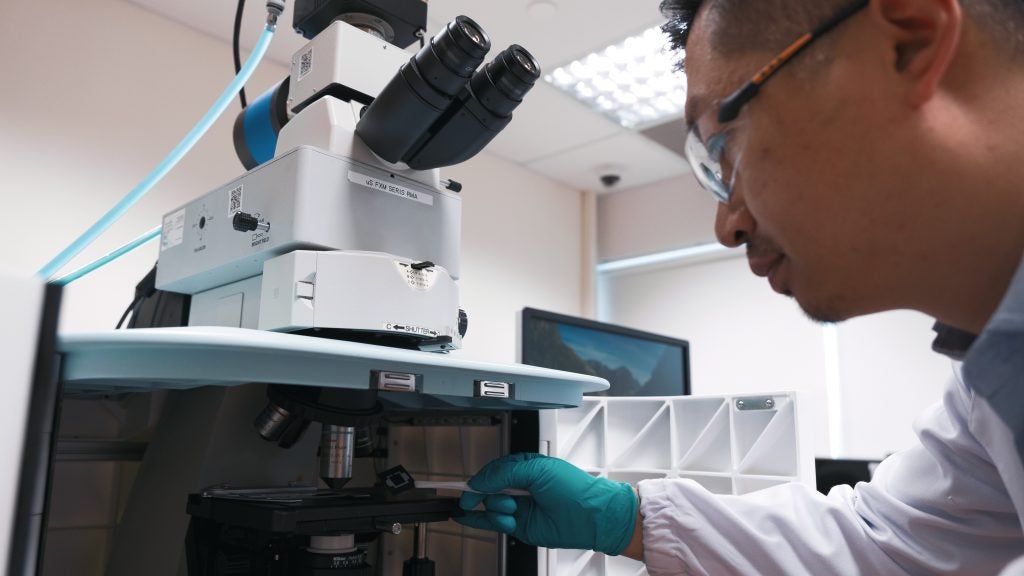
The NUS Satellite Technology And Research Centre (STAR) under CDE recently celebrated the successful launch of its third satellite into orbit.
(Read more about the launch of Lumelite-4 here.)
Among the engineers who worked on the project are several current and former CDE students who played key roles in the design, development and testing of the satellite.
In this article, we hear from two of them about their experience.

Marcus Tay (Mechanical Engineering class of 2022) is currently a Research Engineer at STAR, having joined as a student in 2021 first for an internship and continuing with the centre to pursue his Final Year Project.
In early April he travelled to the Satish Dhawan Space Centre (SDSC) in southern India to assist with the final preparations of the Lumelite-4 mission in the run-up to launch.

Yuan FangXing (Electrical and Computer Engineering class of 2019) undertook his Final Year Project with STAR working on the development of software for satellite communications.
He now works as a Research Associate in STAR’s satellite communication team and handles ground station operations in the Lumelite-4 programme.
Q: How did you come to be involved in the STAR satellite project?
MT: I came across a post on by DSO for my Industrial Attachment in year 3, hiring a satellite engineer to help with assembly, integration and testing for a satellite programme at NUS. I didn’t know much about satellites at that time, but I applied because working with satellites seemed cool as a mechanical engineer and something that is out of reach to a normal engineer. Since then, after seeing the technology and work that is required to put a satellite into space, my interest in space technology has increased exponentially.
YF: After completing my Final Year Project with STAR I was fortunate to be offered a role in the centre where I continued my work on satellite communication. With a personal interest in radio frequency and communication engineering during my undergraduate studies, it’s been amazing to see the knowledge I learned from my studies applied in the space and satellite domain.

Q: What has been your role in preparing the Lumelite-4 satellite for launch?
YF: My role as a communication engineer is to ensure the satellite is capable of establishing contact with our command centre during its mission. This involves functional tests in our cleanroom where our team designed the communication interface module and performed an enclosed radio frequency data transmission test with our ground support equipment. I’m also involved in the development of our ground station in NUS block E4, which is tasked with tracking the satellite and establishing ground contact as it passes overhead.
MT: I was mainly involved in the design, assembly and testing of Lumelite 4 - ensuring that the satellite evolves from parts on the computer screen to coming together in assembly on the cleanroom table. This was followed by environmental testing in the Thermal Vacuum chamber, which simulates conditions in space. I also worked on the design of mechanical ground support equipment to facilitate the handling and integration of the satellite.

Q: Marcus, you were part of the team that travelled to the launch site in India for final preparations, what was the experience like?
MT: Attaching our satellite onto the rocket marks the end of the engineering cycle for this mission and seeing the product of our efforts ready for launch was definitely a moment I will treasure.
The rocket used was the Polar Satellite Launch Vehicle (PSLV), developed by the Indian Space Research Organization, which launches from the Satish Dhawan Space Centre, about three hour's drive from Chennai in southern India. The atmosphere at the launch pad area was surreal! Being able to see the assembly, integration and internals of such a large rocket was an eye-opening experience and very cool.
We travelled to the launch site as part of the final preparations of Lumelite-4, first fitting the satellite into the deployer, which acts as the release mechanism to position it into space. Then we had to do the mechanical integration of the satellite and deployer onto the rocket via the multi-satellite adapter, hooking up the electrical connections from the rocket to our deployer system, enabling the rocket to activate the mechanism to release the satellite into the correct orbit.

Q: How did it feel to see the satellite you had worked on being launched into space?
YF: Watching the rocket being launched into the sky, I felt both excited and nervous. Each announcement of a successfully completed launch phase was met with rounds of applause from our team. Eventually, seeing the satellite being deployed into space, I’m very grateful to see our hard work has paid off!
With Lumelite-4 finally in orbit and working, the experience has been invaluable and will be the foundation for our work on future satellite missions. In the post-launch period, I’ll be engaged in ground pass operations to verify the serviceability of the satellite in orbit and prepare to carry out its mission as the satellite stabilises.
MT: Watching the launch together with my team was an exhilarating event – both thrilling and rewarding! Throughout the build-up, the fear of failure constantly kept us on edge.
I remember the exact moment when the commentator mentioned “Lumelite 4 separated”, we were expecting a live video feed of the separation of our satellite as there was a camera mounted beside the satellite deployer. However, the live stream did not play leaving us with even more uncertainty, although all of us were cheering.
Eventually, when the satellite made the first ground contact and checking that the solar panels were successfully deployed, a huge burden was lifted and we could finally confirm that it was a successful launch.
Launching a satellite is a special event marking the culmination of all our hard work and efforts. Overall, it was a great honour to see the satellite I worked on being launched into space. "

Q: What is one of the biggest learning points you have taken from the project?
MT: For me the biggest learning point is experiencing the whole package of engineering from start to finish. Being able to see your product from development to launch has taught me how the whole engineering spectrum works - how every stage plays a critical role leading up to the final product.
YF: A satellite project at this scale requires a high level of consistency and perseverance. Success depends on breaking down a large goal into small attainable milestones and ensuring each incremental step we achieve is well obtained.
Q: Are you keen to stay in space research and development? Where do you hope your career will go next?
YF: We’re seeing more global involvement and industrial direction focused on space-related applications such as Earth observation, deep space exploration, and even space tourism. So I feel there is lots of potential in space technology for me that I can explore. I’m fortunate to be part of this research centre where we can be one of the early adopters exploring new design ideas.
MT: Satellites are unlike any other mechanical structure: once they are launched into space, they can no longer be retrieved for repair or upgrading. It’s a constraint that increases the engineering challenge and ultimately the satisfaction from success. So, after Lumelite-4, I’m looking forward to designing and developing larger satellites with more advanced materials.
I’m definitely keen to stay in the space field, as what’s on the ground will never be as thrilling and exciting as what’s among the stars.





